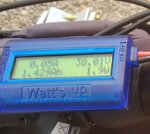It's dealer or manufacturer double speak and insulting to say the ebike buying public doesn't understand or is too stupid to learn the benefits of defined information.
@J.R.
It’s a very new industry, and it barely exists in the US. You posted an article about European ebike owners and their batteries. There was a fairly high level of unhappiness, over time. It’s pretty similar to what the original post said. Just a bike losing range, maybe a battery losing capacity. From the information posted it seems like a pack lost about 30% of capacity, over 14 months and 50 charge cycles. That’s not really what ebike companies are specifying. They generally say 300 cycles to get to 80% capacity.
Contrast this with the electric car industry, where the much larger battery packs are staying pretty close to the original capacity over several years. The ebike and the Teslas use similar, sometimes identical, cells. What is going on? The electric car companies lean toward not using the full capacity of the battery. They charge to maybe 90%. That logic has spread to EBR, but ebike chargers rarely allow people to do a 90% charge. Why? I hope people buy large packs, which they can ‘baby’. Teslas sit in very hot and very cold garages. It’s really hard to understand the problems with ebike batteries.
Buyers have to be at least as smart with the battery as they are with the ebike. Prodeco put LiFePo4 packs on their bikes when I bought a PT bike. People complained about the size and weight. But I used the pack for 18 months and after around 250-300 charge cycles, it had great capacity. They rate LiFePo4 batteries for 2,000 cycles, in some data sheets.
If you put amp hour meters on bikes, people can say what the real capacity of their new battery is, just by running the battery down once. They can make a note of that somewhere and, over time, just see how the capacity is holding up. If they know they have a 12 amp hour ‘true capacity’ they can watch the amp hours on a long ride and know when they are really getting low, say at 10 amp hours consumed. I don’t think this is rocket science. From tests I’ve seen of new batteries, they don’t match the amp hour number in the specs, or printed on the battery, by maybe 5%. That’s a mile or two, on day one.
The more information a rider has, the better. Most ebike riders start to ride faster over time. That will consume more watts per mile, so less range. If they knew this, or just watched a wattmeter every now and then, they would be better able to understand the limits of the battery. If a rider starts out at 15 miles per hour when they get the bike, but then they ride at 20mph in a few months, the range will drop a lot because the motor is going to be doing a lot more of the work and there is a lot more aerodynamic drag.
If you say ‘people don’t need to know this stuff’ good luck with your warranty claims. In other words, if a rider is going 15 mph for a few months, getting 20 miles of range, he thinks that is normal. If the rider gradually moves to going 20 mph, and the range drops to 15 miles, what does he do? Does he file a warranty claim? Will the company be able to sort this out? The best protection for the company would be to have an amp hour meter on the bike, and just use that for warranty claims. There’s really no reason ebike batteries shouldn’t give a couple of years of service and maybe 400 cycles before being at 80% of capacity. If people charged to 90% the research says they would double that. The industry has to be willing to use standard measurements to gauge the condition of used batteries. That means putting this stuff on the bike. They could use diagnostic programming based on a profile of the battery on the bike, if they wanted to insure buyers got the battery pack performance they paid for. Which manufacturers really want their customers to get the exact performance they specify in the sales literature, from their batteries? Which ones are basically playing games with the batteries?
The ebike company should have a partnership with the owners of the products they sell, whether bikes or parts. Owners should be encouraged to use ‘good’ chargers that protect the capacity of the battery packs. People should know what capacity means, relative to ‘range’, which depends a lot on speed. Range is a function of speed and battery capacity, but range is not a good measure of battery capacity. It makes sense to get extra capacity and only charge to 90%.
